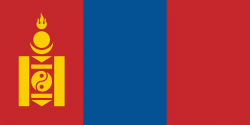Bürentogtokh (Bayan)
Bürentogtokh (Бүрэнтогтох, lit. "to set completely") is a sum (district) of Khövsgöl aimag (province of Mongolia). The area is about 3,760 km², of which 2,870 km² are pasture. In 2005, the sum had 4251 inhabitants, mainly Khalkha and Khotgoid. The center, officially named Bayan (Баян) is situated on the banks of the Delgermörön river, 51 km west of Mörön and 722 kilometers from Ulaanbaatar.
Marshal Chingünjav, one of the two major leaders of a failed rebellion against the Manchu in 1755/6, was born at Sangiin Dalai nuur. The remains of his fort can still be seen a few km south of the sum center.
In 1877, Sodnomyn Damdinbazar was inaugurated as Jalkhanz Khutagt at Jalkhanzyn Khüree, located on the territory of what is now Bürentogtokh sum. He served as Prime Minister twice, 1921 in Baron Ungern's puppet government, and 1922/23 under the MPRP.
The Bürentogtokh sum was founded, together with the whole Khövsgöl aimag, in 1931. In 1933, it had about 2,600 inhabitants in 752 households, and about 90,000 heads of livestock. In 1973, the Büren and Bürenkhaan sums were dissolved and partially joined to Bürentogtokh sum. Between 1952 and 1990, Bürentogtokh was the seat of the Delgermörön negdel.
Marshal Chingünjav, one of the two major leaders of a failed rebellion against the Manchu in 1755/6, was born at Sangiin Dalai nuur. The remains of his fort can still be seen a few km south of the sum center.
In 1877, Sodnomyn Damdinbazar was inaugurated as Jalkhanz Khutagt at Jalkhanzyn Khüree, located on the territory of what is now Bürentogtokh sum. He served as Prime Minister twice, 1921 in Baron Ungern's puppet government, and 1922/23 under the MPRP.
The Bürentogtokh sum was founded, together with the whole Khövsgöl aimag, in 1931. In 1933, it had about 2,600 inhabitants in 752 households, and about 90,000 heads of livestock. In 1973, the Büren and Bürenkhaan sums were dissolved and partially joined to Bürentogtokh sum. Between 1952 and 1990, Bürentogtokh was the seat of the Delgermörön negdel.
Map - Bürentogtokh (Bayan)
Map
Country - Mongolia
 |
|
| Flag of Mongolia | |
The territory of modern-day Mongolia has been ruled by various nomadic empires, including the Xiongnu, the Xianbei, the Rouran, the First Turkic Khaganate, and others. In 1206, Genghis Khan founded the Mongol Empire, which became the largest contiguous land empire in history. His grandson Kublai Khan conquered China proper and established the Yuan dynasty. After the collapse of the Yuan, the Mongols retreated to Mongolia and resumed their earlier pattern of factional conflict, except during the era of Dayan Khan and Tumen Zasagt Khan. In the 16th century, Tibetan Buddhism spread to Mongolia, being further led by the Manchu-founded Qing dynasty, which absorbed the country in the 17th century. By the early 20th century, almost one-third of the adult male population were Buddhist monks. After the collapse of the Qing dynasty in 1911, Mongolia declared independence, and achieved actual independence from the Republic of China in 1921. Shortly thereafter, the country became a satellite state of the Soviet Union, which had aided its independence from China. In 1924, the Mongolian People's Republic was founded as a socialist state. After the anti-communist revolutions of 1989, Mongolia conducted its own peaceful democratic revolution in early 1990. This led to a multi-party system, a new constitution of 1992, and transition to a market economy.
Currency / Language
| ISO | Currency | Symbol | Significant figures |
|---|---|---|---|
| MNT | Mongolian tögrög | ₮ | 2 |
| ISO | Language |
|---|---|
| MN | Mongolian language |
| RU | Russian language |















